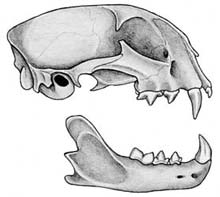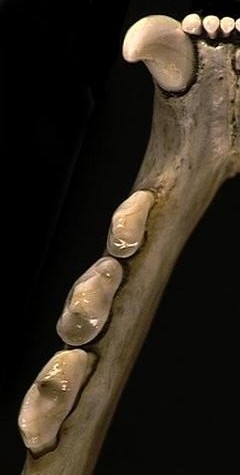
Nutrition
The Lynx rufus habitat is
solely dependent on the availability of food (Baugh 2011). To survive, the bobcat relies strictly on eating other
animals, their only source of nutrition (A-Z Animals 2013). Bobcats
are carnivores and prey on animals such as birds, turkeys, rabbits,
bats, rodents, and small deer. A typical eating period for the
Lynx rufus results in the consumption of three pounds of meat.
If a bobcat was to capture a larger animal, like a deer, it will
cover and revisit the animal to feed multiple times (Stokes 1986).
2011). To survive, the bobcat relies strictly on eating other
animals, their only source of nutrition (A-Z Animals 2013). Bobcats
are carnivores and prey on animals such as birds, turkeys, rabbits,
bats, rodents, and small deer. A typical eating period for the
Lynx rufus results in the consumption of three pounds of meat.
If a bobcat was to capture a larger animal, like a deer, it will
cover and revisit the animal to feed multiple times (Stokes 1986).
The Lynx rufus is a very versatile animal which
allows them to capture their prey efficiently. The bobcat has
advanced abilities of sounds and vision which allows them to quietly
observe their pray before they pounce in attack. They can catch
their predators with surprise by sneaking up using their soft padded
paws (Berendes 2004). The bobcat uses their claws to catch their
prey, and then bites into the animal’s neck using their sharp, long teeth. The Lynx rufus has 28 teeth, including their
four essential canine teeth. These sharp teeth allow them to rip off
multiple, small pieces of meat off their prey to consume without
even having to chew (National Trappers Association 2013).
long teeth. The Lynx rufus has 28 teeth, including their
four essential canine teeth. These sharp teeth allow them to rip off
multiple, small pieces of meat off their prey to consume without
even having to chew (National Trappers Association 2013).
Bobcats learn their hunting abilities as a baby. Harvested in
dens, mothers teach their young to hunt -- the father does not help
in this process. A mother will leave the den and return with small
live animals, like mice. The young Lynx rufus will practice
their hunting abilities under the mother’s supervision. By two
months, the bobcat graduates from drinking the mother’s milk and
their diet converted entirely to adult food. They stay with their
mother for a short period, but after a few months are half grown and
ready to be independent and self-sufficient (Stokes 1986).
To continue to learn about the Lynx rufus check out the
body features.